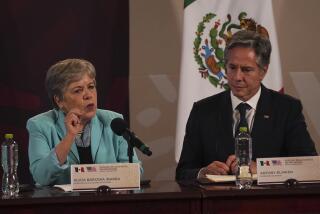MEXICO : Cultural Rift Slows Pace of Chiapas Peace Talks
- Share via
MEXICO CITY — Along one edge of the square negotiating table sat ski-masked Maya Indians, half of them in ceremonial regalia of woolen tunics and beribboned straw hats.
Facing them across the room were highly trained Mexican technocrats, among them Marco Antonio Bernal, a veteran of government social programs, and prominent diplomat Gustavo Iruegas, experienced in finding common ground for different views.
Between the two groups was a gaping cultural rift that cut short last weekend’s first face-to-face talks aimed at solving the smoldering conflict in the southernmost state of Chiapas. That schism between delegates of the government and the Zapatista National Liberation Army does not augur well for the negotiations, set to resume May 12.
“What we have are two ways of seeing the world,” said Pablo Romo, director of the Fray Bartolome de las Casas Human Rights Center in nearby San Cristobal de las Casas.
“Neither side is looking for an intermediate space,” he said. “Instead of being a road, where both sides try to meet in the middle, they are acting like a freeway, where one is going above and the other below, without connecting.”
Ironically, both sides say they have the same goals: better living standards for the poorest Mexicans and greater democracy for all Mexicans. But four days of wrangling last week accomplished remarkably little toward those goals.
The delegates spent the first two days arguing long-distance--with the government team in San Cristobal de las Casas and the rebels an hour away at the talk site in San Andres Larrainzar--over whether the crowds of Zapatista supporters at the negotiations represented a security risk.
When they finally sat down in a temporary building constructed over a basketball court, talks stalled on the first tough issue: The rebels want the Mexican army to pull out of the former Zapatista-controlled territory, and the government is not willing to pull back.
They could not reach any compromise on the issue. As a result, Zapatista delegates are asking their communities to consider two conflicting proposals that are, from all appearances, the same ideas each side presented originally.
This inauspicious beginning has observers on both sides worried about the prospects for the talks.
“They seem completely unable to understand each other,” said one government official, who asked not to be identified.
The government approaches the talks with an expectation of clear rules and roles that should be obeyed, an approach that Romo calls “the logic of power.” From the government perspective, for example, the only Zapatista supporters who needed to be at the talks were the delegates and the community members who were going to participate in the security measures. The crowd of onlookers appeared to be an effort at intimidation.
But Indian traditions call for far more community participation.
Overlying the cultural differences is a history of distrust and broken government promises. “They have tried to get the government’s attention with petitions, marches and finally war, and nothing has worked,” Romo said.
“There is just no effort at understanding between these two worlds. This can be overcome. But no one is making the effort.”
More to Read
Sign up for Essential California
The most important California stories and recommendations in your inbox every morning.
You may occasionally receive promotional content from the Los Angeles Times.













